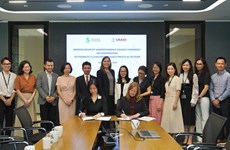Thai farmers urge common shrimp export standards
A representative for shrimp farmers in Thailand has urged the government to
enter into negotiations with other major world importers to set down a general
system of standards for their shrimps.
A representative for shrimp farmers in Thailand has urged the government to
enter into negotiations with other major world importers to set down a general
system of standards for their shrimps.
The call came amidst growing concerns that the different criteria used by Thailand ’s major shrimp export markets are one of the main causes of the rise in production costs for local farmers.
Thai farmers must observe ‘Good Agricultural Practices’ to ensure their products meet international standards on food safety and other issues such as levels of antibiotic residues should be included in the negotiations, said the President of the Thai Shrimp Association(TSA), Somsak Paneetatyasai.
The European Union now uses the ‘Global Gap’ criteria on shrimps imported to the bloc while Australia has its ‘Import Risk Analysis’ to test shrimp imports.
The US giant retailer Wal-Mart even requires exporters to provide official recognition from its ‘Aquaculture Certification Council’ before exporting their shrimps to the US market.
According to the TSA’s President, Thailand will remain the world’s leading shrimp exporter next year with an estimated output of around 380,000 tonnes. The country exported 320,000 tonnes of shrimps in the first ten months of this year, up 8 percent from the corresponding period last year.
At present, the US is Thailand’s largest importer, purchasing 45-49 percent of Thailand’s total exports every year.
TSA statistics suggest that Thailand is the world’s second biggest shrimp producer with an average output of 540,000 tonnes every year, after China with 560,000 tonnes.
Vietnam is the world’s third largest shrimp producer and this year’s production is estimated at 220,000 tonnes. Indonesia and India rank 4th and 5th respectively./.
The call came amidst growing concerns that the different criteria used by Thailand ’s major shrimp export markets are one of the main causes of the rise in production costs for local farmers.
Thai farmers must observe ‘Good Agricultural Practices’ to ensure their products meet international standards on food safety and other issues such as levels of antibiotic residues should be included in the negotiations, said the President of the Thai Shrimp Association(TSA), Somsak Paneetatyasai.
The European Union now uses the ‘Global Gap’ criteria on shrimps imported to the bloc while Australia has its ‘Import Risk Analysis’ to test shrimp imports.
The US giant retailer Wal-Mart even requires exporters to provide official recognition from its ‘Aquaculture Certification Council’ before exporting their shrimps to the US market.
According to the TSA’s President, Thailand will remain the world’s leading shrimp exporter next year with an estimated output of around 380,000 tonnes. The country exported 320,000 tonnes of shrimps in the first ten months of this year, up 8 percent from the corresponding period last year.
At present, the US is Thailand’s largest importer, purchasing 45-49 percent of Thailand’s total exports every year.
TSA statistics suggest that Thailand is the world’s second biggest shrimp producer with an average output of 540,000 tonnes every year, after China with 560,000 tonnes.
Vietnam is the world’s third largest shrimp producer and this year’s production is estimated at 220,000 tonnes. Indonesia and India rank 4th and 5th respectively./.













